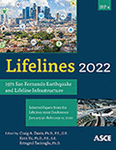Effects of Ground Strain and Pipeline Orientation on Pipeline Damage during Earthquakes
Publication: Lifelines 2022
ABSTRACT
Pipeline damage correlations are used for risk studies of water distribution systems. One of the parameters correlated with pipeline damage in permanent ground deformation zones is horizontal (lateral) ground strain. Some damage correlations use the maximum absolute value of the two principal strains around the pipelines as the lateral ground strain parameter. However, strains caused by lateral ground movements can be resolved into components such as axial strains in the direction of the pipelines. Performing such a process for a large urban water distribution system is a relatively complicated task and development of damage relationships requires comprehensive ground deformation and pipeline data. The unprecedented database following the Canterbury Earthquake Sequence in New Zealand (NZ) provides an opportunity to explore the effects of ground strain and pipeline orientation on pipeline damage during earthquakes. This study presents the GIS methodology for using pipeline orientation to evaluate pipeline network damage caused by ground deformation during earthquakes. The geospatial analyses results indicate differences in the responses of asbestos cement (AC) and cast iron (CI) segmental pipelines under compressive and tensile axial strains.
Get full access to this article
View all available purchase options and get full access to this chapter.
REFERENCES
ALA (American Lifelines Alliance). (2001). Seismic fragility formulations for water systems, Part I-Guideline, ASCE.
Ballantyne, D. (2010). “Seismic vulnerability assessment and design of pipelines.” J. Am. Water Work. Assoc., 102 (5), 88–97.
Bellagamba, X., Bradley, B. A., Wotherspoon, L. M., and Hughes, M. W. (2019). “Development and validation of fragility functions for buried pipelines based on canterbury earthquake sequence data.” Earthquake Spectra. 35(3):1061-1086. doi:https://doi.org/10.1193/120917EQS253M.
Bouziou, D., and O’Rourke, T. D. (2019). “Probabilistic Approach to Axial Pipeline Strain Caused by Permanent Ground Deformations and the Case of Ground Strain Effects on Pipeline Damage During the 22 February 2011 Christchurch Earthquake.” Proceedings, ICOHNIC, Chania, Greece.
Bouziou, D., and O’Rourke, T. D. (2017). “Response of the Christchurch water distribution system to the 22 February 2011 earthquake.” Soil Dynam. Earthq. Eng., 97,14–24.
Bray, J. D., O’Rourke, T. D., Cubrinovski, M., Zupan, J. D., Jeon, S. S., Taylor, M., Toprak, S., Hughes, M., van Ballegooy, S., and Bouziou, D. (2013). Liquefaction impact on critical infrastructure in Christchurch., 22 March 2013.
CGD (Canterbury Geotechnical Database). (2012). Liquefaction interpreted from aerial photography, map layer CGD0200, <https://canterburygeotechnicaldatabase.projectorbit.com>(Feb. 11, 2013).
Cook, R. D. (1995). Finite element modeling for stress analysis. John Wiley and Sons.
Cubrinovski, M., Hughes, M., Bradley, B., Noonan, J., Hopkins, R., McNeill, S., and English, G. (2014). Performance of Horizontal Infrastructure in Christchurch City through the 2010-2011 Canterbury Earthquake Sequence, University of Canterbury, Christchurch, New Zealand.
Davis, C. A. (2014). Water system service categories, post-earthquake interaction, and restoration strategies, Earthquake Spectra 30, 1487–1509.
ESRI (Environmental Systems Research Institute). (2011). ArcGIS Desktop: Release 10. Redlands.
Nacaroglu, E. (2017). Damage assessment of buried pipeline systems under seismic effects. PhD. Thesis Denizli, Turkey, Pamukkale Univ.
O’Rourke, M., and Deyoe, E. (2004). “Seismic damage to segmented buried pipe.” Earthquake Spectra. 20(4):1167-1183.
O’Rourke, M. J. (2009). “Analytical fragility relations for buried segmented pipe.” Proceedings of 2009 TCLEE Conference, Lifeline Earthquake Engineering in a Multihazard Environment, ASCE, Reston, VA.
O’Rourke, M. J., and Liu, X. (1999). Response of buried pipelines subject to earthquake effects. : Multidisciplinary Center for Earthquake Engineering Research. Buffalo, NY.
O’Rourke, T. D., and Toprak, S. (1997). “GIS assessment of water supply damage from the Northridge earthquake.” eds. J. D. Frost, Geotechnical Special Publication, ASCE, New York, NY, 117–131.
O’Rourke, T. D., Jeon, S. S., Toprak, S., Cubrinovski, M., Hughes, M., Ballegooy, S., and Bouziou, D. (2014). “Earthquake response of underground pipeline networks in Christchurch, NZ.” Earthq Spectra, 30(1):183–204.
Pineda-Porras, O., and Najafi, M. (2010). “Seismic damage estimation for buried pipelines: challenges after three decades of progress.” J. Pipeline Syst. Eng. Pract. 1, 19–24.
QGIS (Geographic Information System). (2020). “Open Source Geospatial Foundation Project”, <http://qgis.org>.
Toprak, S., and Taskin, F. (2007). “Estimation of earthquake damage to buried pipelines caused by ground shaking.” Natural hazards, Springer, 40(1), 1-24.
Toprak, S., Nacaroglu, E., and Koc, A. C. (2016). “How important the ground strain and pipeline orientation for the seismic damages.” 4th International Conference on New Developments in Soil Mechanics and Geotechnical Engineering, Near East University, Nicosia, North Cyprus.
Toprak, S., Nacaroglu, E., Koc, A. C., O’Rourke, T. D., Hamada, M., Cubrinovski, M., and Ballegooy, S. (2018). “Comparison of horizontal ground displacements in Avonside area, Christchurch from air photo, LiDAR and satellite measurements regarding pipeline damage assessment.” Bull Earthq Eng, 16 (10), 4497–4514.
Toprak, S., Nacaroglu, E., Van Ballegooy, S., Koc, A. C., Jacka, M., Manav, Y., Torvelainen, E., and O’Rourke, T. D. (2019). “Segmented pipeline damage predictions using liquefaction vulnerability parameters”, Soil Dynamics and Earthquake Engineering, 125, 105758.
Toprak, S., O’Rourke, T. D., and Tutuncu, I. (1999). “GIS characterization of spatially distributed lifeline damage.” Proc. 5th US Conference on Lifeline Earthquake Engineering, ASCE, Reston, VA, 110–119.
Information & Authors
Information
Published In
History
Published online: Nov 16, 2022
Authors
Metrics & Citations
Metrics
Citations
Download citation
If you have the appropriate software installed, you can download article citation data to the citation manager of your choice. Simply select your manager software from the list below and click Download.
